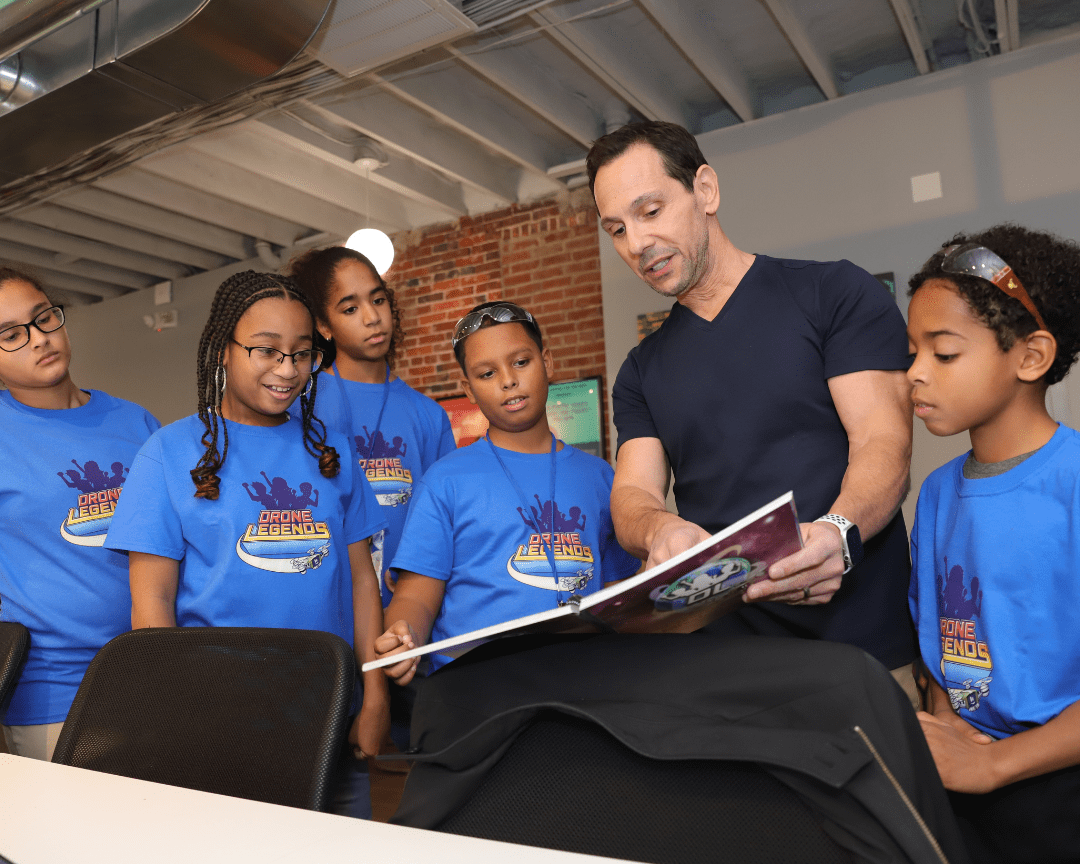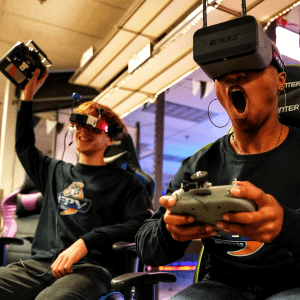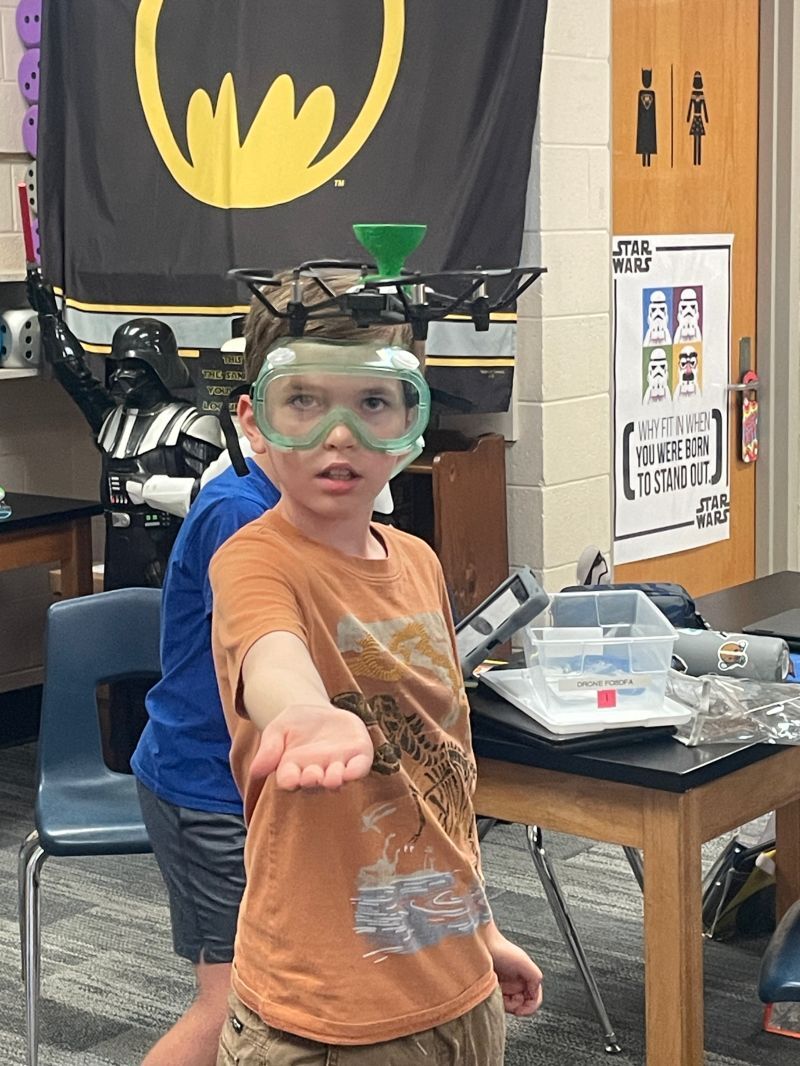Drones and STEM are… an ideal pairing. Pretty much every high priority STEM concept is reinforced when kids engage in our drone programs. Of course, just flying a drone around the yard isn’t (by osmosis or exposure or something) going to teach kids physics, math, engineering, etc. What is going to teach kids all of those important things is a comprehensive, standards-aligned STEM curriculum. Spoiler alert: we have that. Check it out here.
Whether you are an administrator, educator, or an adult invested in your students’ development, here are eight powerful STEM concepts kids learn through drones.
1. Physics in Action
For kids, discoveries that are rooted in real world experience are the most memorable. What they see and feel will stick. Whether in or out of the classroom, drones illustrate physical principles like lift, thrust, drag, angular momentum, and more. One of the things we love most about using drones to demonstrate concepts like these is they force kids into the “why.” If the drone doesn’t make it off the table: why? If the flight path deviates unexpectedly: why? If it crashes: why? This forces kids into investigation mode, which drives them deeper into physics and troubleshooting to find their own answers because they want to learn.
2. Understanding Mechanics
This is a huge one, because mechanical machinery will always be a guiding force in new technology. Exposure to technology may seem like it’s everywhere for kids, but using drones introduces an important layer of complexity. Drones aren’t just digital: they are mechanical. Understanding the mechanics of how moving parts work is actually less common for kids nowadays, since the devices they use are fully enclosed and kids rarely see the “inner-workings” of machines. Drones expose the moving parts, which connects key concepts and illustrates the “how” behind tech.
3. Remote Control Concepts
Aeronautical engineers at mission control, trucking industry dispatchers, even pilots are just a few of the myriad of careers in which remote control knowledge is essential. Drones help children understand how remote control works. They have to maintain line of sight (for the safety factor), use hand-eye coordination, and navigate a three-dimensional space. All of these are great big beautiful skills they can use in virtually any profession.
4. Real-World Math
If STEM or STEAM could be effectively conveyed through the common written or spoken word, every kid would pass every test and tick every box. That’s not how developing brains work, though. Children are at various levels of development, including the ability to process abstract concepts. As it turns out, math has many components that are abstract… as are many elements in engineering, art, science, you name it. Drones take the theory and make it real. Kids can touch drones, read their numerical data, and break down their functionality. This provides an important experiential opportunity that supports mathematical understanding.
5. Spatial and Abstract Planning
A key developmental milestone is when kids can do fine motor spatial planning (that’s how they learn to space letters). Drones extend this development by facilitating larger-scale and increasingly complex planning efforts. Where things go, how long it takes them to get there, how they travel from point A to point B: these are all fundamental elements of flight planning that have way bigger applications for kids. There is a great deal of math involved, whether or not kids realize that’s exactly what they’re doing, and calculating with precision is essential to pulling off a successful drone mission.
6. Coding and Programming
This has become a bit of a buzzword that every ambitious parent is attracted to. But all coding really is (at this level) is learning how to provide clear instruction in a very specific format. That exercise alone is incredibly valuable and similar to learning to read music. The brain has to stretch to remember, then reuse, precise patterns, or the drone simply won’t work correctly. The real-life payoff of coding drones is in immediate success or failure, which provides kids with a great feedback loop to either celebrate or head back to the drawing board.
7. Leadership and Working Together
At least in the context of drone classes, drone clubs, or drone camps: kids can use drones to learn STEM but do so… together. When it comes to STEM careers, we at Drone Legends talk about this a lot: we don’t want kids to just have technical knowledge but to be good humans who can work well with others. Flying drones requires leadership, giving and receiving directions, coping with failure, offering encouragement, and sticking to something that may be hard. All of these are important social-emotional skills, fueled by a fun STEM experience.
8. Environment, Geography, and Topology
Students have an ever-expanding worldview. They start being aware of their very tiny bubble and grow to realize the world is far bigger than they imagined. Introducing STEM concepts using drones drags this awareness out even further, providing a unique perspective on the world. Consider how drone footage makes us zoom out, enlarging our understanding and helping us (quite literally) see things differently. It does this for kids, too, in a scalable way. Once kids get an appetite for what drones have to offer, their understanding of the environment, of locations of things, of regions, and even of the physical makeup of the world (mountains, valleys, etc.) can grow.
EXTRA: Citizenship and Community
In the last five years, really, drones have escalated immeasurably in common use. They’re used to water fields and capture satellite images and deliver medicine. Drones are everywhere. It’s important for all kids – whether they’re tech-savvy or not – to envision themselves as useful members of society. That’s one of the many reasons we’ve set up our STEM curriculum to include missions. Students are immersed in a narrative where they use a drone to do something important. This community connection affirms their individual and collective importance, and is an epically empowering moment that can capture the imagination and shape the trajectory of their lives.
Drone Legends for Learning STEM Concepts
At Drone Legends, we believe that inside every child lives a legend. It’s a big deal for us to offer an academically rigorous, methodologically sound STEM curriculum that administrators and teachers can trust, but that kids also deeply enjoy. We are so proud to be trusted, and know that what we are doing — together with every hero teacher and program coordinator out there — is impacting kids in a powerful way. To schedule a discovery call and learn more about Drone Legends curriculum for your school, after school program, or camp: click or tap here.




